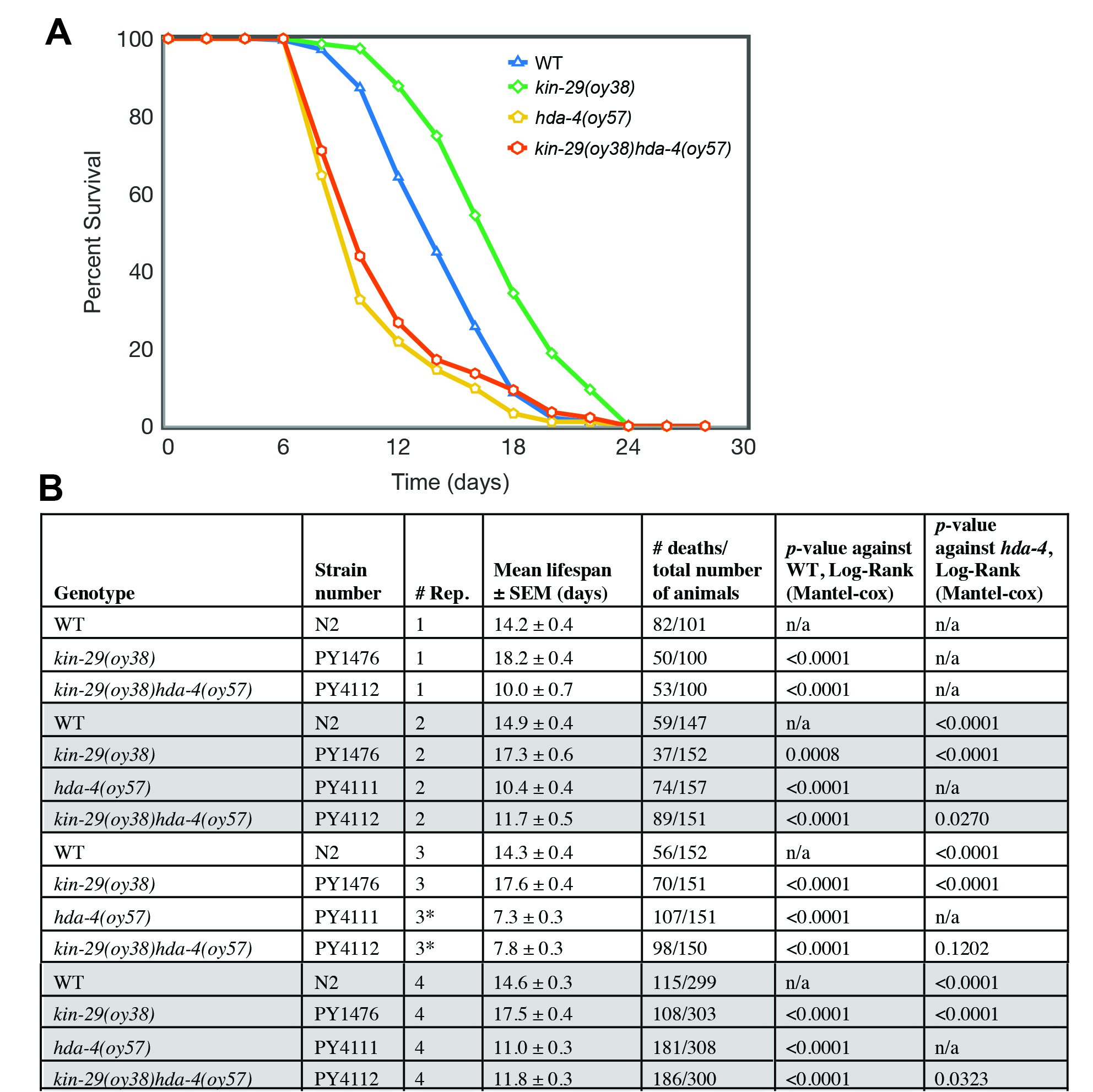Description
kin-29 encodes the C. elegans homolog of mammalian Salt-Inducible Kinases (SIKs). kin-29 mutants are small, have increased propensity to develop into non-reproductive dauer larvae, have reduced chemoreceptor gene expression (Lanjuin and Sengupta, 2002; van der Linden et al.., 2007), have reduced cellular ATP despite increased fat stores, and show reduced sleep (Grubbs et al., 2020). KIN-29 phosphorylates and inhibits the class II histone deacetylase 4 homolog HDA-4 to regulate gene expression in sensory neurons (van der Linden et al., 2007). The longevity phenotype of kin-29 mutants is suppressed by mutations in daf-16 (Lanjuin and Sengupta, 2002), which encodes a forkhead box protein O (FOXO) transcription factor (Kenyon et al., 1993). These results indicated that the increased lifespan of kin-29 mutants may be due to reduced insulin signaling.
To determine whether HDA-4 is required for the KIN-29 regulation of lifespan, we performed a survival analysis. As previously reported (Lanjuin and Sengupta, 2002), kin-29(oy38) mutants are long-lived. In contrast, hda-4(oy57) mutants are short lived (Fig. 1). The kin-29hda-4 double mutant longevity phenotype was similar to the phenotype of hda-4 single mutants (Fig. 1), suggesting that hda-4 acts downstream of kin-29 to regulate lifespan. Together with our previous findings (van der Linden et al., 2007), these genetic results suggest that KIN-29 may regulate lifespan via the action of HDA-4. Since SIKs can inhibit FOXO activity via HDAC4 to regulate gene expression (Mihaylova et al., 2011; Wang et al., 2011), it would be interesting in future studies to test the model that KIN-29/HDA-4 signaling converges on DAF-16/FOXO to modulate gene expression associated with longevity.
Methods
Request a detailed protocolAll strains were maintained at 20°C for at least two generations before the lifespan assay. Lifespan assays were conducted at 20°C by placing age-synchronized L4 larvae of wild-type and the indicated genotypes on 6-cm diameter plates containing nematode growth media (NGM) plates and 5 μM 5’-fluoro-2’-deoxyuridine (FUDR) (Sigma) seeded with ~1011 E. coli OP50 bacterial cells per ml and 10-15 worms per plate. The number of dead hermaphrodites was scored every two days until all worms were dead, and the percentage of survival was calculated. Death was scored as a lack of movement after a nose touch. Animals that experienced ventral rupture, bagging or walling were censored from the analysis. ~100-300 animals from each strain were used for each biological replicate. Statistical analyses and survival curves were performed with the Online Application for Survival Analysis software (OASIS 2, https://sbi.postech.ac.kr/oasis2/ (Han et al., 2016). The significance of differences in mean lifespan was calculated using the Log-Rank test.
Reagents
Strains used in this study are the wild-type strain N2 variety Bristol (Brenner, 1974), PY1476 kin-29(oy38), PY4111 hda-4(oy57), and PY4112 kin-29(oy38)hda-4(oy57) (Lanjuin and Sengupta, 2002; van der Linden et al., 2007). All strains are available at the CGC. The deletion/rearrangement in the oy38 allele was confirmed by the polymerase chain reaction (PCR) and the single nucleotide change in oy57 allele by sequencing of a PCR product.
Acknowledgments
We would like to thank David Raizen for valuable comments and edits on our micro-manuscript, and members of the van der Linden lab for discussions on the micro-manuscript. We thank Piali Sengupta and the CGC for providing strains.
References
Funding
This work was supported by the National Institutes of Health grant R01NS107969. Some strains were provided by the Caenorhabditis Genetics Center, which is funded by the NIH office of Research Infrastructure Programs (P40 OD010440).
Reviewed By
AnonymousHistory
Received: April 23, 2020Revision received: July 31, 2020
Accepted: July 31, 2020
Published: August 9, 2020
Copyright
© 2020 by the authors. This is an open-access article distributed under the terms of the Creative Commons Attribution 4.0 International (CC BY 4.0) License, which permits unrestricted use, distribution, and reproduction in any medium, provided the original author and source are credited.Citation
Nikooei, T; McDonagh, A; M. van der Linden, A (2020). The salt-inducible kinase KIN-29 regulates lifespan via the class II histone-deacetylase HDA-4. microPublication Biology. 10.17912/micropub.biology.000289.Download: RIS BibTeX




